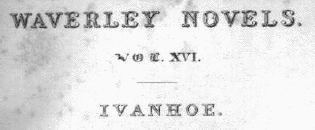
When Walter Scott was working on Waverley (1805) but left with
only the opening chapters written. The grater verve and dash of Byron's
narrative poems threatened to oust Scott from his position as supreme purveyor
of this kind of literary entertainment, and he was looking for another
vein. In the autumn of 1813 he accidentally came across the unfinished
manuscript of Waverley, and completed it. It was published anonymously
in July 1814 by Constable, with John Ballantyne & Co. doing the printing;
Constable got half the profits, Scott the other half. Scott preserved his
anonymity because he felt that it was not quite becoming in a clerk of
session to write novels, then considered a rather frivolous form of literature.
Leaving Edinburh to buzz with excitement and speculation about Waverley,
Scott set off at the end of July on a visit to the northern and western
islands in the yacht of the lighthhoyuse commissioner. This six-weed trip
provided him with Scottish scenes he was later to use in novels.
Waverley was followed by Guy Mannerig (1815), "the work
of six weeds at Christmas"; The Antiquary (1816); two series
of Tales of My Landlord (1816-19), which included Old
Mortality and The Heart of Midlothian; Rob
Roy (1818); a third series of Tales of My Landlord
included The Bride of Lammermoor and The Legend of
Montrose (1819). It was only after writing these novels of Scottish
history that Scott, driven by financial need and the need to satisfy the
public appetite for historical fiction that he had created, turned to themes
from English history with Ivanhoe,
The
Monastery, and The Abbot (all 1820). ThePirate,
set in the Orkneys, and The Fortunes of Nigel were published
in 1822. Later novels included Quentin Durward (1823),
St.
Ronan's Well (1824), and, also in 1824, the last and one of the
best of his Scottish novels, Redgauntlet. As a historical
novelist dealing with medieval England, or France, or Germany, or the crusaders'
Palestine, Scott showed a flair for highly coloured picturesque incident
and situation. He also exhibited in varying degrees a sense of the poetry
of history and an ability to project in terms of character and action something
of the life and manners of the feudal ages. But he becomes a more complex
and mature novelist the nearer he comes to his own time and country. Ivanhoe
and The
Talisman are colourful, somewhat theatrical, novels of
rather obviously stylizad period characters and action. Quentin Durward,
Kenilworth
(1821), and The Fortunes of Nigel, set respectively in the
15th, 16th, and 17th centuries, show a greater awareness of the complexities
of the human situation and less disposition to be content with colourful
surface action arising from the histrionic attitudes of somewhat cardboard
figures who speak an invented antique dialect. Scott was nearly always
better with minor and often lowclass figures than with conventional heroes
and heroines who had to act out the love story which the reader demanded
but which never engaged Scott's real interest. He wrote too fast, and he
wrote simply to entertain, and his novels often show a lack of artistic
conscience. In dealing with picturesque aspects of the distant past, as
well as on the one occasion, in St. Ronan's Well, when he
dealt with the surface of life in his own day, Scott's imagination worked
perfunctorily and did not draw on its deepest sources of inspiration. His
real claim to greatness as a novelist rests on the "Scotch novels."
In dealing with the recent past of his own country Scott was able to
find a fictional form to express the deep ambituities of his own feeling
about Scotland. One side of him welcomed the union with England and the
commercial progress and modernization whith it promised to bring; the other
regretted bitterly the loss of Scotland's independence and the steady decline
of its national consciousness and traditions.
Scott became a novelist by bringing his antiquarian and romantic feeling
for Scotland's past and for a heroic age into relation with his sense that
Scotland's interest demanded that she break with the past and look forward
to a prudently commercial "British" future. Civilization must be paid for
by ghe cessation of the old kind of individual heroic action; the heroic
characters in the end become histrionic or even ludicrous, and the humble
or the prudent remain: Rob Roy is dismissed as a ranting exhibitionist
and Bailie Nicol Jarvie, survives into the future. And in The Heart
of Midlothian the obviously heroic actions turn out to be merely
criminal and sordid, and true heroism is found in the behaviour of Jeanie
Deans.
This information has been extracted to Academic year 2000/2001
British Encyclopedia, Inc. © a.r.e.a./ Dr. Vicente Forés López
© 1973 © Sergio Clavijo Ruiz
Universidad de Valencia Press
sercla@alumni.uv.es
